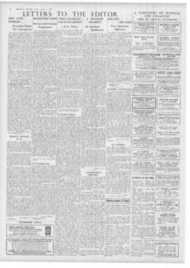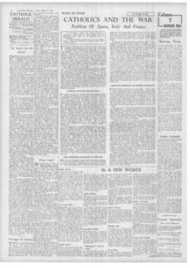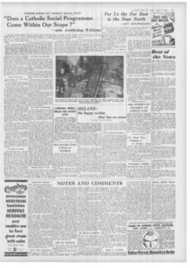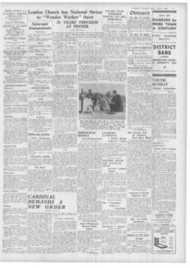Page 7, 9th August 1940
Page 7

Report an error
Noticed an error on this page?If you've noticed an error in this article please click here to report it.
Tags
Share
Related articles
Fr. Martindale Recalls Churchless Pinner Festival Of
In Pinner's Streets The Annual Procession Of St. Philomena
Pinner Procession Fr. Martindale On Religious Persecution
England As Strong As Her Moral Laws
"the Creat Adventure"
London Church has National Shrine to " Wonder Worker " Saint
25 YEARS' PROGRESS
AT PINNER
From a C.H. Reporter
IF there were no war, and if Fr. C. Martindale, S.J., were with us in England Fr. Martindale would again carry St. Philomena's Relics through the
streets, as he did yearly from 1933 up till last year, in solemn procession, and would say a few appropriate words to the puzzled but respectful crowd gathered in the High Street. Better days will see the revival of what was fast becoming a treasured tradidon in London Catholic life, the annual public celebrations at Pinner to honour the thirteen-year-old Roman martyr of whom so little is known.
Accustomed as I am to seeing in recent residence in the North churches which, when popularity attaches to them for one reason or another, are large and spacious, I was disappointed in the dimensions of St. Luke's, Pinner; I had never been there before, and I expected to flnd•ampler proportions.
A shadowy interior, however, accentuates its devotional character, and if it lacks the cold arrogance of the massive brick piles accumulated in industrial areas in the last decade, and called good examples of churches of the neo-Romanesque (or neosomething-or-the-other) style, St. Luke's fits in easily with the scheme of things in II quiet London suburban street.
THANKS TO ST. PHILOMENA
But there is a charming history to St. Luke's, as well as to St. Philomena's Shrine set up in the church, and if the present parish priest can only sit 150 members of his congregation of 400 at a time within the building, he could not even do this had not, as he himself relates, the Saint intervened to make it possible.
The Rev. J. Caulfield carve in 1911 to Pinner and started a parish with 20 souls. Saying Mass in an empty house, he placed his undertaking under the care of St. 'Philomena, to whom at the suggestion of his mother he had developed a special personal devotion, and was able to have one aisle of a new church opened on the Feast of St. Luke, October 18, 1915. Thus this year the church will celebrate its Silver jubilee. " Without the inspiration, confidence and help which our little Saint gave me during those trying war years, when my little congregation was thinning out," says Fr. Caulfield, " I could not possibly have survived."
To liquidate a debt on a new presbytery alongside his church, he organised his now famous annual " Pinner Derby," a Shetland pony race, ridden by all the 171051 P1710115 jockeys of the day. It drew an enormous crowd, provided the means, and sent the presbytery fund up higher and higher. Orre of the jockeys gave the statue of the Cure d'Ars which adorns Si. Philornena's chapel.
In 1927, on occasion of the Silver Jubilee of Fr. Caulfield's ordination, the late Mr. Joseph O'Malley Moore, of Dublin, editor of Si. Anthony's Annals, presented Fr. Caulfield with the statue of St. Philomena, and thus began the Shrine, and in May, 1930, Fr. Caulfield received certain relics of the Saint, which are new deposited in an oak casket. Mural paintings in the chapel followed in time, together with a window of the Curt d'Ars, who was himself devoted to the Saint in his lifetime.
A CURE
The blessing of the present Holy Father, as well as that of Pope Pius XI, was hestowed on the Shrine in due course, and apart from many cases of favours which have been received through St. Philomena's intercession and which have come to the notice of Fr. Caulfield, there is the special case of a London man who was instantaneously cured from diabetes in 1934, after praying at the Shrine. Medical and hospital certificates relating to the case are to be seen on the chapel wall.
When I called on Fr. Caulfield I found that he now has a curate, the Rev. Denis O'Sullivan. who came three weeks ago from Hackney, and who brings with him a keen interest in the Catholic Press and in youth. But both he and his parish priest have still to struggle to clear the £4.000 debt on the church, and there is no " Donkey Derby" to help!
For the feast of St. Philomena next Sunday, the choir front Hackney church will sing at the principal Mass, and the Rev. F. Greaves, curate at Hackney, will preach. The sermon at the evening service will be by Fr. J. J. Bevan, of the Oratory.
St. Philomena is believed to have lived and died for the Faith in the second century, but devotion to her is modern. In 1802 excavators in the catacomb of St. Priscilla, Rome, discovered a tomb bearing the following inscription: " Lunrena parte curnfi," which there was good reason to think meant: "Pax tecum Philomena" (Peace to thee, Philomena).
Painted symbols of martyrdom were found too, as also the remains of a B-year-old girl, and a half-broken glass vase with its sides covered with dried blood. Three years later the relics were deposited in the Saint's sanctuary at Megnano, near Naples, where they now rest. Many miracles are attributed to the Saint's intercession, and it is related how the crystal reliquary wherein were deposited the dried remains of the blood was changed partly into a substance of the finest gold, and partly into rubies, emeralds, diamonds and other precious stones.
Pauline Jaricot, foundress of the Society of the Propagation of the Faith, owed her complete cure from a violent form of heart disease to St. Philomena, A Papal decree authorising devotion to the Saint was published in 1837, and in 1854 Pius IX granted a Proper Office of St. Philomena with three Lessons, in addition to a Feast with Mass from the Common of a Virgin Martyr for August 11, "pro aliquibus locis," the latter permitted by decree of Pope Gregory XVI in 1837.
blog comments powered by Disqus









